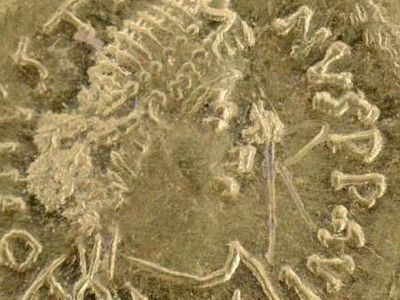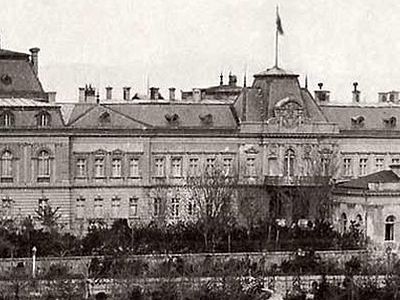Source: Archaeology in Bulgaria
January 27, 2016
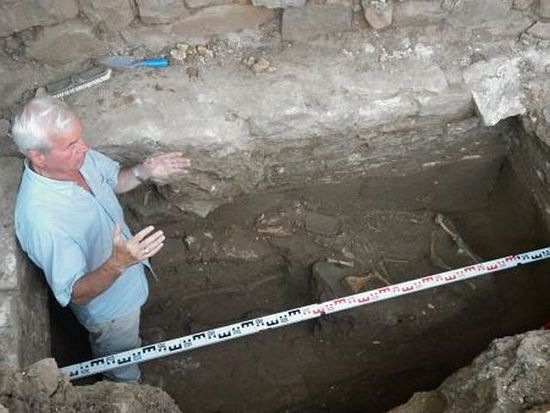 Bulgarian archaeologist Prof. Kazimir Popkonstantinov is pictured here with the sheep skeleton discovered inside the Early Christian tomb on the St. Ivan (St. John) Island in the Black Sea off the coast of Bulgaria’s Sozopol. Photo: BurgasNews
Bulgarian archaeologist Prof. Kazimir Popkonstantinov is pictured here with the sheep skeleton discovered inside the Early Christian tomb on the St. Ivan (St. John) Island in the Black Sea off the coast of Bulgaria’s Sozopol. Photo: BurgasNews
The establishment of an Early Christian monastery dedicated to St. John the Baptist with the saint’s relics in Bulgaria’s Black Sea resort town of Sozopol (known as Apollonia Pontica in ancient times) may have been motivated by the existence of a huge statue and a temple of pagan god Apollo in the Antiquity period.
This is a hypothesis of lead archaeologist Prof. Kazimir Popkonstantinov who discovered the relics of St. John the Baptist amid the ruins of the Early Byzantine St. John the Baptist Monastery on the St. Ivan (St. John) Island right off the coast of Sozopol back in 2010, and in 2015, found a tomb possibly containing the bones of the monastery founder, a Syrian monk who brought the relics.
The establishment of the Early Christian monastery on island in the Black Sea off Sozopol’s coast dedicated to “one of the three strongest personalities in Early Christianity" may have been designed and executed by the Patriarchate of Constantinople “as a counterpoint of the impressive statue and shrine of the pagan god Apollo", reckons Popkonstantinov, an expert in Christian archaeology, as cited by the 24 Chasa daily.
His hypothesis comes against the backdrop of plans to rebuild the 13-meter statue of Apollo, the major landmark of the Ancient Greek polis of Apollonia Pontica (today’s Sozopol) even though the archaeologist has made no reference to these plans.
It is known that the statue of Apollo in today’s Sozopol, also known as the Colossus of Apollonia because of the parallels to the Colossus of Rhodes, one of the Seven Wonders of the Ancient World, decorated the port of Apollonia Pontica for more than 400 years, from the time of its erection ca. 480 BC until in 72 BC, Marcus Lucullus, one of the great generals of the Roman Republic, captured the city, seized the statue as a trophy, and had it transported to Rome, and installed on one of the historic hills of the Roman capital.
According to different ancient authors, the Apollo statue was installed either on the Palatine Hill or on the Capitoline Hill in Rome, and stood there for another 400 years, until the Late Antiquity, giving the “Colossus of Apollonia" a combined lifespan of some 800 years. It is said to have been destroyed by Christians outraged by its nudity after Christianity became the official religion in the Roman Empire in the 4th century AD.
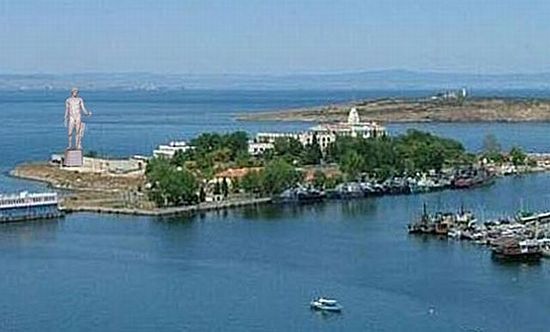 A 2011 collage showing what the 13-meter-tall Colossus of Apollonia might have looked like> Here it is shown on the St. Cyricus Island (today a peninsula) in Bulgaria’s Sozopol. The St. Ivan Island where the relics of St. John the Baptist were found is visible in the background. Photo: e-vestnik
A 2011 collage showing what the 13-meter-tall Colossus of Apollonia might have looked like> Here it is shown on the St. Cyricus Island (today a peninsula) in Bulgaria’s Sozopol. The St. Ivan Island where the relics of St. John the Baptist were found is visible in the background. Photo: e-vestnik
While the Apollo statue was taken from Sozopol to Rome in the 1st century BC, the polis of Apollonia Pontica is also known to have had a large temple dedicated to Apollo.
According to Popkonstantinov’s newly voiced hypothesis as to why Sozopol was picked to host the monastery with the relics from St. John the Baptist established in the 4th-5th century AD, the cult for Apollo must have been rather persistent in Apollonia Pontica regardless of the removal of the Colossus several centuries earlier.
“During this early period when Christianity was imposed as the religion of the Empire, a lot of shrines from the pagan period were turned into churches. Even the Parthenon in Athens was turned into a [Christian] temple dedicated to the Holy Mother of God (Virgin Mary)," Popkonstantinov says.
He cites an example from Italy in which an Early Christian monastery was built at a site with a still operational shrine of Apollo: in 526 AD, St. Benedict of Nursia (ca. 480-543/7) built a monastery dedicated to St. John the Baptist in Monte Cassino.
“This is why the Bulgarian analogy of this monastery is extremely interesting for the researchers," Popkonstantinov notes.
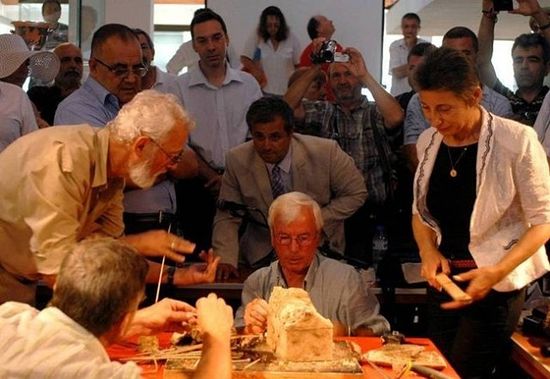 This 2010 photo shows Prof. Kazimir Popkonstantinov (middle) opening in front of journalists a reliquary he found on the St. Ivan Island which turned out to contain relics from St. John the Baptist. Photo: Prof. Kazimir Popkonstantinov/24 Chasa daily
This 2010 photo shows Prof. Kazimir Popkonstantinov (middle) opening in front of journalists a reliquary he found on the St. Ivan Island which turned out to contain relics from St. John the Baptist. Photo: Prof. Kazimir Popkonstantinov/24 Chasa daily
While his hypothesis with respect to the potential connection between the existence of the Colossus of Apollonia Pontica and the establishment of the Early Christian monastery with St. John the Baptist relics off the coast of Sozopol is yet to be tested, the lead archaeologist is also resorting to laboratory tests of his major discovery from the summer of 2015.
Samples from the bones of the two men whose tomb was found in the ruins of the monastery on St. Ivan Island will be sent for DNA tests to laboratories at Oxford University and the University of Copenhagen.
In early 2015, scholars from Oxford University using DNA testing confirmed that the relics found by Popkonstantinov on the small Black Sea island in 2010 belonged to a Middle Eastern man who lived in the 1st century AD, and died between 50 and 70 AD.
Upon the discovery of the reliquary containing the relics of St. John the Baptist back in 2010, Popkonstantinov and his team found next to it a matchbox-sized box made of sandstone (the type of sandstone found in Middle Eastern countries such as Syria and Palestine); on it, there were an inscription in Ancient Greek, reading “God, save your servant Thomas (Toma). To St. John. June 24." The date is the Christian feast day of St. John the Baptist, believed to be his birthday.
The DNA samples from the newly discovered Early Christian tomb in Bulgaria’s Sozopol will be tested by the same scholars who tested the relics of St. John the Baptist– Prof. Tom Higham from the School of Archaeology at Oxford University in the UK and Prof. Eske Willerslev from the Center of Excellence in Geo-Genetics at the University of Copenhagen in Denmark.
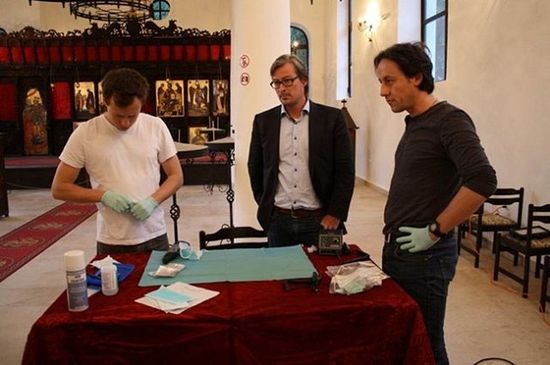 Dr. Hannes Schroeder (left) and Prof. Eske Willerslev (middle) from the University of Copenhagen and Prof. Tom Higham from Oxford University are seen here extracting DNA samples from the relics of St. John the Baptist kept at the St. Cyril and St. Methodius Church in Bulgaria’s Sozopol back in 2014. Photo: Prof. Kazimir Popkonstantinov/24 Chasa daily
Dr. Hannes Schroeder (left) and Prof. Eske Willerslev (middle) from the University of Copenhagen and Prof. Tom Higham from Oxford University are seen here extracting DNA samples from the relics of St. John the Baptist kept at the St. Cyril and St. Methodius Church in Bulgaria’s Sozopol back in 2014. Photo: Prof. Kazimir Popkonstantinov/24 Chasa daily
The new DNA testing of the bone finds from the Early Christian monastery is expected to help prove or disprove Popkonstantinov’s hypothesis that one of the two skeletons in the tomb belonged to that same Thomas from the sandstone box inscription, who brought the relics of St. John the Baptist and must have been the founder of the monastery.
The tomb found last summer at a depth of 3.5 meters dates back to the end of the 4thand the beginning of the 5th century AD. It was built almost at the same time as the monastery basilica adjacent to the northern part of its altar but outside of the temple. One of the men buried inside it was aged 45-50, and the other was 50-55. Inside the tomb, Popkonstantinov also found the skeleton of a sheep.
“The tradition for this sacred room outside the temple is to bury very important persons. On top of the skeleton in the southern part of the tomb, about 25 cm above it, we also found a sheep skeleton placed in an anatomically correct order. This marvelous discovery resolves some of the main questions we’ve had regarding the monastery," explains the lead archaeologist.
He believes he knows what must have happened: the church on St. Ivan Island was damaged in an earthquake in the 6th-7th century AD, and when it was rebuilt, the new temple was made narrower so as not to affect the tomb because the two men buried in it were the founders of the monastery, and one of them was probably the Thomas mentioned in the relics inscription. Since the monks saw the buried men as their patrons before God, they offered a sheep as a sacrifice to secure protection for the monastery against future earthquakes.
“Thomas may have been close to the Patriarch of Constantinople and so he was tasked with the establishment of the monastery. He must have had a great authority in order to have been able to go to Antioch, and take particles from the relics of St. John the Baptist for this important monastery. This was an extraordinary deed, "Popkonstantinov hypothesizes.
The samples from the bones of the two buried men will be extracted for the laboratory analyses in the UK and Denmark in February 2016.
“We have been in touch with Tom Higham who is going to find out whether the men were buried in the 4th-5th century, i.e. the time when the church was built. We already have results about the sheep. It was buried at the end of the 6th or the beginning of the 7th century which provides a reference point for the destruction of the church [by the earthquake]," Popkonstantinov elaborates.
He assumes that Thomas, the founder of the monastery who brought the St. John the Baptist relics to Sozopol, was a monk from Syria because the basilica on the St. Ivan Island is similar to the Early Christian churches in Syria.
“There are only three churches of [the Syrian] type in Bulgaria – one in Montana, one in Varna, and this one on the St. Ivan Island, which shows that the monks who founded the monastery were Syrian. There was a major presence of Syrians on [Bulgaria’s] Black Sea coast in the 4th-5th century AD because they were resettled there by the Byzantine emperors," says the archaeologist.
Popkonstantinov and his wife, fellow archaeologist Assoc. Prof. Rosina Kostova, are going to continue their excavations on the St. Ivan Island off the coast of Sozopol during the summer of 2016. They will be seeking another Early Christian tomb, and also trying to find out the planning of the eastern part of the church.
The two archaeologists have set up a foundation named “St. John the Forerunner and the Baptist" that will be drafting cultural tourism projects for the conservation and restoration of the St. John the Baptist Monastery which is the best preserved Early Christian monastery on any of the islands in the entire Black Sea.
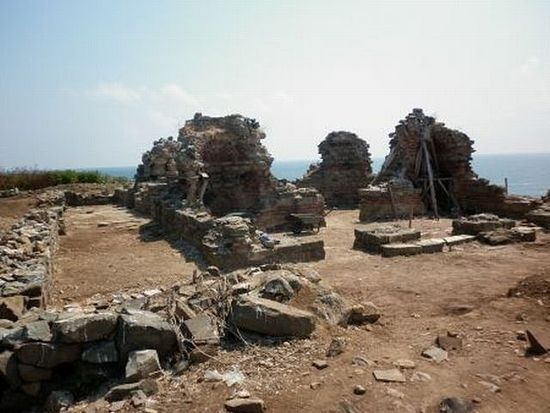 Part of the ruins of the Early Christian St. John the Baptist Monastery on the St. Ivan (St. John) Island in the Black Sea off the coast of Bulgaria’s Sozopol. Photo: BurgasNews
Part of the ruins of the Early Christian St. John the Baptist Monastery on the St. Ivan (St. John) Island in the Black Sea off the coast of Bulgaria’s Sozopol. Photo: BurgasNews
The history of the resort town of Sozopol (Apollonia Pontica, Sozopolis) on Bulgaria’s Southern Black Sea coast started during the Early Bronze Age, in the 5thmillennium BC, as testified by the discoveries of artifacts found in underwater archaeological research, such as dwellings, tools, pottery, and anchors. In the 2nd-1stmillennium BC, the area was settled by the Ancient Thracian tribe Scyrmiades who were experienced miners trading with the entire Hellenic world. An Ancient Greek colony was founded there in 620 BC by Greek colonists from Miletus on Anatolia’s Aegean coast. The colony was first called Anthea but was later renamed to Apollonian favor of Ancient Greek god Apollo, a patron of the setters who founded the town. It became known as Apollonia Pontica (i.e. of the Black Sea). Since the Late Antiquity, the Black Sea town has also been called Sozopolis.
The Greek colony of Apollonia Pontica emerged as a major commercial and shipping center, especially after the 5th century AD when it became allied with the Odrysian Kingdom, the most powerful state of the Ancient Thracians. As of the end of the 6thcentury BC, Apollonia Pontica started minting its own coins, with the anchor appearing on them as the symbol of the polis. Apollonia became engaged in a legendary rivalry with another Ancient Greek colony, Mesembria, today’s Bulgarian resort town of Nessebar, which was founded north of the Bay of Burgas in the 6thcentury BC by settlers from Megara, a Greek polis located in West Attica. According to some historical accounts, in order to counter Mesembria’s growth, Apollonia Pontica founded its own colony, Anchialos, today’s Pomorie (though other historical sources do not support this sequence of events), which is located right to the south of Mesembria. Apollonia managed to preserve its independence during the military campaigns of the Ancient Greek kingdom of Macedon under Philip II (r. 359-336 BC), and his son Alexander the Great (r. 336-323 BC). Apollonia, today’s Sozopol, is known to have had a large temple of Greek god Apollo (possibly located on the Sts. Quiricus and Julietta Island, also known as the St. Cyricus Island), with a 12-meter statue of Apollo created by Calamis, a 5th century BC sculptor from Ancient Athens. In 72 BC, Apollonia Pontica was conquered by Roman general Lucullus who took the Apollo statue to Rome and placed it on the Capitoline Hill. After the adoption of Christianity as the official religion in the Roman Empire, the statue was destroyed.
In the Late Antiquity, Apollonia, also called Sozopolis lost some of its regional center positions to Anchialos, and the nearby Roman colony Deultum (Colonia Flavia Pacis Deultensium). After the division of the Roman Empire into a Western Roman Empire and Eastern Roman Empire (today known as Byzantium) in 395 AD, Apollonia /Sozopolis became part of the latter. Its Late Antiquity fortress walls were built during the reign of Byzantine Emperor Anastasius (r. 491-518 AD), and the city became a major fortress on the Via Pontica road along the Black Sea coast protecting the European hinterland of Constantinople.
In 812 AD, Sozopol was first conquered for Bulgaria by Khan (or Kanas) Krum, ruler of the First Bulgarian Empire (632/680-1018 AD) in 803-814 AD. In the following centuries of medieval wars between the Bulgarian Empire and the Byzantine Empire, Sozopol changed hands numerous times. The last time it was conquered by the Second Bulgarian Empire (1185-1396 AD) was during the reign of Bulgarian Tsar Todor (Teodor) Svetoslav Terter (r. 1300-1322 AD). However, in 1366 AD, during the reign of Bulgarian Tsar Ivan Alexander (r. 1331-1371 AD), Sozopol was conquered by Amadeus IV, Count of Savoy from 1343 to 1383 AD, who sold it to Byzantium. During the period of the invasion of the Ottoman Turks at the end of the 14th century and the beginning of the 15th century AD, Sozopol was one of the last free cities in Southeast Europe. It was conquered by the Ottomans in the spring of 1453 AD, two months before the conquest of Constantinople despite the help of naval forces from Venice and Genoa.
In the Late Antiquity and the Middle Ages, Sozopol was a major center of (Early) Christianity with a number of large monasteries such as the St. John the Baptist Monastery on St. Ivan Island off the Sozopol coast where in 2010 Bulgarian archaeologist Prof. Kazimir Popkonstantinov made a major discovery by finding relics of St. John the Baptist; the St. Apostles Monastery; the St. Nikolay (St. Nikolaos or St. Nicholas) the Wonderworker Monastery; the Sts. Quriaqos and Julietta Monastery on the St. Cyricus (St. Kirik) Island, the Holy Mother of God Monastery, the St. Anastasia Monastery.
During the Ottoman period Sozopol was often raided by Cossack pirates. In 1629, all Christian monasteries and churches in the city were burned down by the Ottoman Turks leading it to lose its regional role. In the Russian-Turkish War of 1828-1829,Sozopol was conquered by the navy of the Russian Empire, and was turned into a temporary military base. After Bulgaria’s National Liberation from the Ottoman Empire in 1878, Sozopol remained a major fishing center. As a result of intergovernmental agreements for exchange of population in the 1920s between theTsardom of Bulgaria and the Kingdom of Greece, most of the ethnic Greeks still remaining in Sozopol moved to Greece, and were replaced by ethnic Bulgarians from the Bulgarian-populated regions of Northern Greece.
The modern era archaeological excavations of Sozopol were started in 1904 by French archaeologists who later took their finds to The Louvre Museum in Paris, including ancient vases from the beginning of the 2nd millennium BC, the golden laurel wreath of an Ancient Thracian ruler, and a woman’s statue from the 3rd century BC. Important archaeological excavations of Sozopol were carried out between 1946 and 1949 by Bulgarian archaeologist Ivan Venedikov. The most recent excavations of Sozopol’s Old Town started in 2010. In 2011-2012, Bulgarian archaeologists Tsonya Drazheva and Dimitar Nedev discovered a one-apse church, a basilica, and an Early Christian necropolis. Since 2012, the excavations of Sozopol have been carried out together with French archaeologists. In 2010, during excavations of the ancient monastery on the St. Ivan (St. John) Island in the Black Sea, off the coast of Sozopol, Bulgarian archaeologist Prof. Kazimir Popkonstantinov discovered a reliquary containing relics of St. John the Baptist. In 1974, the Bulgarian government set up the Old Sozopol Archaeological and Architectural Preserve.

